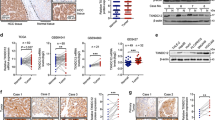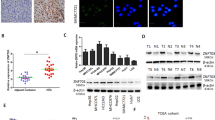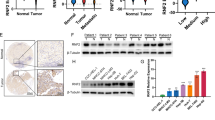Abstract
Claudins (CLDNs) are a family of integral membrane proteins central to the formation of tight junctions, structures that are involved in paracellular transport and cellular growth and differentiation, and are critical for the maintenance of cellular polarity. Recent studies have provided evidence that CLDNs are aberrantly expressed in diverse types of human cancers, including hepatocellular carcinomas (HCCs). However, little is known about how CLDN expression is involved in cancer progression. In this study, we show that CLDN1 has a causal role in the epithelial–mesenchymal transition (EMT) in human liver cells, and that the c-Abl-Ras-Raf-1-ERK1/2 signaling axis is critical for the induction of malignant progression by CLDN1. Overexpression of CLDN1 induced expression of the EMT-regulating transcription factors Slug and Zeb1, and thereby led to repression of E-cadherin, β-catenin expression, enhanced expression of N-cadherin and Vimentin, a loss of cell adhesion, and increased cell motility in normal liver cells and HCC cells. In line with these findings, inhibition of either c-Abl or ERK clearly attenuated CLDN1-induced EMT, as evidenced by a reversal of N-cadherin and E-cadherin expression patterns, and restored normal motility. Collectively, these results indicate that CLDN1 is necessary for the induction of EMT in human liver cells, and that activation of the c-Abl-Ras-Raf-1-ERK1/2 signaling pathway is required for CLDN1-induced acquisition of the malignant phenotype. The present observations suggest that CLDN1 could be exploited as a biomarker for liver cancer metastasis and might provide a pivotal point for therapeutic intervention in HCC.
This is a preview of subscription content, access via your institution
Access options
Subscribe to this journal
Receive 50 print issues and online access
$259.00 per year
only $5.18 per issue
Buy this article
- Purchase on Springer Link
- Instant access to full article PDF
Prices may be subject to local taxes which are calculated during checkout






Similar content being viewed by others
Abbreviations
- EMT:
-
epithelial–mesenchymal transition RNA
- PI3K:
-
phosphoinositide 3-kinase
- siRNA:
-
small interfering.
References
Roberts LR . Sorafenib in liver cancer—just the beginning. N Engl J Med 2008; 359: 420–422.
Thorgeirsson SS, Grisham JW . Molecular pathogenesis of human hepatocellular carcinoma. Nat Genet 2002; 31: 339–346.
Tung-Ping Poon R, Fan ST, Wong J . Risk factors, prevention, and management of postoperative recurrence after resection of hepatocellular carcinoma. Ann Surg 2000; 232: 10–24.
Kummar S, Shafi NQ . Metastatic hepatocellular carcinoma. Clin Oncol (R Coll Radiol) 2003; 15: 288–294.
Fidler IJ . The pathogenesis of cancer metastasis: the 'seed and soil' hypothesis revisited. Nat Rev Cancer 2003; 3: 453–458.
Singh A, Settleman J . EMT cancer stem cells and drug resistance: an emerging axis of evil in the war on cancer. Oncogene 2010; 29: 4741–4751.
Yoon CH, Kim MJ, Lee H, Kim RK, Lim EJ, Yoo KC et al. PTTG1 promotes tumor malignancy via epithelial to mesenchymal transition and expansion of cancer stem cell population. J Biol Chem 2012; 287: 19516–19527.
Mitic LL, Anderson JM . Molecular architecture of tight junctions. Annu Rev Physiol 1998; 60: 121–142.
Balda MS, Matter K . The tight junction protein ZO-1 and an interacting transcription factor regulate ErbB-2 expression. Embo J 2000; 19: 2024–2033.
Balda MS, Matter K . Tight junctions at a glance. J Cell Sci 2008; 121 (Pt 22): 3677–3682.
Hartsock A, Nelson WJ . Adherens and tight junctions: structure, function and connections to the actin cytoskeleton. Biochim Biophys Acta 2008; 1778: 660–669.
Brennan K, Offiah G, McSherry EA, Hopkins AM . Tight junctions: a barrier to the initiation and progression of breast cancer? J Biomed Biotechnol 2010; 2010: 460607.
Mullin JM . Potential interplay between luminal growth factors and increased tight junction permeability in epithelial carcinogenesis. J Exp Zool 1997; 279: 484–489.
Ren J, Hamada J, Takeichi N, Fujikawa S, Kobayashi H . Ultrastructural differences in junctional intercellular communication between highly and weakly metastatic clones derived from rat mammary carcinoma. Cancer Res 1990; 50: 358–362.
Morita K, Furuse M, Fujimoto K, Tsukita S . Claudin multigene family encoding four-transmembrane domain protein components of tight junction strands. Proc Natl Acad Sci USA 1999; 96: 511–516.
Escudero-Esparza A, Jiang WG, Martin TA . The Claudin family and its role in cancer and metastasis. Front Biosci 2011; 16: 1069–1083.
Morin PJ . Claudin proteins in human cancer: promising new targets for diagnosis and therapy. Cancer Res 2005; 65: 9603–9606.
Cheung ST, Leung KL, Ip YC, Chen X, Fong DY, Ng IO et al. Claudin-10 expression level is associated with recurrence of primary hepatocellular carcinoma. Clin Cancer Res 2005; 11 (2 Pt 1): 551–556.
Sakaguchi T, Suzuki S, Higashi H, Inaba K, Nakamura S, Baba S et al. Expression of tight junction protein claudin-5 in tumor vessels and sinusoidal endothelium in patients with hepatocellular carcinoma. J Surg Res 2008; 147: 123–131.
Yoon CH, Kim MJ, Park MJ, Park IC, Hwang SG, An S et al. Claudin-1 acts through c-Abl-protein kinase Cdelta (PKCdelta) signaling and has a causal role in the acquisition of invasive capacity in human liver cells. J Biol Chem 2010; 285: 226–233.
Pearson G, Robinson F, Beers Gibson T, Xu BE, Karandikar M, Berman K et al. Mitogen-activated protein (MAP) kinase pathways: regulation and physiological functions. Endocr Rev 2001; 22: 153–183.
Woodring PJ, Hunter T, Wang JY . Regulation of F-actin-dependent processes by the Abl family of tyrosine kinases. J Cell Sci 2003; 116 (Pt 13): 2613–2626.
Silberman I, Sionov RV, Zuckerman V, Haupt S, Goldberg Z, Strasser A et al. T cell survival and function requires the c-Abl tyrosine kinase. Cell Cycle 2008; 7: 3847–3857.
Huang Y, Yuan ZM, Ishiko T, Nakada S, Utsugisawa T, Kato T et al. Pro-apoptotic effect of the c-Abl tyrosine kinase in the cellular response to 1-beta-D-arabinofuranosylcytosine. Oncogene 1997; 15: 1947–1952.
Yuan ZM, Huang Y, Whang Y, Sawyers C, Weichselbaum R, Kharbanda S et al. Role for c-Abl tyrosine kinase in growth arrest response to DNA damage. Nature 1996; 382: 272–274.
Jallal H, Valentino ML, Chen G, Boschelli F, Ali S, Rabbani SAA . Src/Abl kinase inhibitor, SKI-606, blocks breast cancer invasion, growth, and metastasis in vitro and in vivo. Cancer Res 2007; 67: 1580–1588.
Noren NK, Foos G, Hauser CA, Pasquale EB . The EphB4 receptor suppresses breast cancer cell tumorigenicity through an Abl-Crk pathway. Nat Cell Biol 2006; 8: 815–825.
Podtcheko A, Ohtsuru A, Tsuda S, Namba H, Saenko V, Nakashima M et al. The selective tyrosine kinase inhibitor, STI571, inhibits growth of anaplastic thyroid cancer cells. J Clin Endocrinol Metab 2003; 88: 1889–1896.
Suzuki J, Shishido T . Regulation of cellular transformation by oncogenic and normal Abl kinases. J Biochem 2007; 141: 453–458.
Maeda M, Johnson KR, Wheelock MJ . Cadherin switching: essential for behavioral but not morphological changes during an epithelium-to-mesenchyme transition. J Cell Sci 2005; 118 (Pt 5): 873–887.
Si SH, Yang JM, Peng ZH, Luo YH, Zhou P . Effects of KAI1 gene on growth and invasion of human hepatocellular carcinoma MHCC97-H cells. World J Gastroenterol 2004; 10: 2019–2023.
Agarwal R, D’Souza T, Morin PJ . Claudin-3 and claudin-4 expression in ovarian epithelial cells enhances invasion and is associated with increased matrix metalloproteinase-2 activity. Cancer Res 2005; 65: 7378–7385.
Berx G, Van Roy F . The E-cadherin/catenin complex: an important gatekeeper in breast cancer tumorigenesis and malignant progression. Breast Cancer Res 2001; 3: 289–293.
Martin TA, Jiang WG . Loss of tight junction barrier function and its role in cancer metastasis. Biochim Biophys Acta 2009; 1788: 872–891.
Palacios J, Sarrio D, Garcia-Macias MC, Bryant B, Sobel ME, Merino MJ . Frequent E-cadherin gene inactivation by loss of heterozygosity in pleomorphic lobular carcinoma of the breast. Mod Pathol 2003; 16: 674–678.
Michl P, Barth C, Buchholz M, Lerch MM, Rolke M, Holzmann KH et al. Claudin-4 expression decreases invasiveness and metastatic potential of pancreatic cancer. Cancer Res 2003; 63: 6265–6271.
Usami Y, Chiba H, Nakayama F, Ueda J, Matsuda Y, Sawada N et al. Reduced expression of claudin-7 correlates with invasion and metastasis in squamous cell carcinoma of the esophagus. Hum Pathol 2006; 37: 569–577.
Oshima T, Kunisaki C, Yoshihara K, Yamada R, Yamamoto N, Sato T et al. Reduced expression of the claudin-7 gene correlates with venous invasion and liver metastasis in colorectal cancer. Oncol Rep 2008; 19: 953–959.
Kang Y, Massague J . Epithelial-mesenchymal transitions: twist in development and metastasis. Cell 2004; 118: 277–279.
Tokes AM, Kulka J, Paku S, Szik A, Paska C, Novak PK et al. Claudin-1, -3 and -4 proteins and mRNA expression in benign and malignant breast lesions: a research study. Breast Cancer Res 2005; 7: R296–R305.
Kramer F, White K, Kubbies M, Swisshelm K, Weber BH . Genomic organization of claudin-1 and its assessment in hereditary and sporadic breast cancer. Hum Genet 2000; 107: 249–256.
Kominsky SL, Argani P, Korz D, Evron E, Raman V, Garrett E et al. Loss of the tight junction protein claudin-7 correlates with histological grade in both ductal carcinoma in situ and invasive ductal carcinoma of the breast. Oncogene 2003; 22: 2021–2033.
Myal Y, Leygue E, Blanchard AA . Claudin 1 in breast tumorigenesis: revelation of a possible novel ‘claudin high’ subset of breast cancers. J Biomed Biotechnol 2010; 2010: 956897.
Wels C, Joshi S, Koefinger P, Bergler H, Schaider H . Transcriptional activation of ZEB1 by Slug leads to cooperative regulation of the epithelial-mesenchymal transition-like phenotype in melanoma. J Invest Dermatol 2011; 131: 1877–1885.
Ku JL, Park JG . Biology of SNU cell lines. Cancer Res Treat 2005; 37: 1–19.
Singh A, Greninger P, Rhodes D, Koopman L, Violette S, Bardeesy N et al. A gene expression signature associated with ‘K-Ras addiction’ reveals regulators of EMT and tumor cell survival. Cancer Cell 2009; 15: 489–500.
Moffat J, Grueneberg DA, Yang X, Kim SY, Kloepfer AM, Hinkle G et al. A lentiviral RNAi library for human and mouse genes applied to an arrayed viral high-content screen. Cell 2006; 124: 1283–1298.
Acknowledgements
This work was supported by the National Research Foundation (NRF) and Ministry of Education, Science and Technology (MEST), Korean government, through its National Nuclear Technology Program (2012M2A2A7035878) and Converging Research Center Program Grant (2011K000877) funded by the Ministry of Education, Science and Technology.
Author Contributions: Yongjoon Suh: collection and assembly of data, data analysis and interpretation, paper writing; Chang-Hwan Yoon: collection and assembly of data, data analysis and interpretation; Rae-Kwon Kim: collection of data; Eun-Jung Lim: collection of data; Yeong Seok Oh: collection of data; Sang-Gu Hwang: data analysis and interpretation; Sungkwan An: data analysis and interpretation; Gyesoon Yoon: data analysis and interpretation; Myung Chan Gye: data analysis and interpretation; Joo-Mi Yi: data analysis and interpretation; Min-Jung Kim: collection of data Su-Jae Lee: conception and design, paper writing, data analysis and interpretation, final approval of paper.
Author information
Authors and Affiliations
Corresponding author
Ethics declarations
Competing interests
The authors declare no conflict of interest.
Additional information
Supplementary Information accompanies the paper on the Oncogene website
Rights and permissions
About this article
Cite this article
Suh, Y., Yoon, CH., Kim, RK. et al. Claudin-1 induces epithelial–mesenchymal transition through activation of the c-Abl-ERK signaling pathway in human liver cells. Oncogene 32, 4873–4882 (2013). https://doi.org/10.1038/onc.2012.505
Received:
Revised:
Accepted:
Published:
Issue Date:
DOI: https://doi.org/10.1038/onc.2012.505
Keywords
This article is cited by
-
Disabled-2, a versatile tissue matrix multifunctional scaffold protein with multifaceted signaling: Unveiling its potential in the cancer battle
Naunyn-Schmiedeberg's Archives of Pharmacology (2024)
-
Overexpression of the NEK9–EG5 axis is a novel metastatic marker in pathologic stage T3 colon cancer
Scientific Reports (2023)
-
ZEB1 is a Subgroup-Specific Marker of Prognosis and Potential Drug Target in Medulloblastoma
NeuroMolecular Medicine (2023)
-
MicroRNAs as the critical regulators of tyrosine kinase inhibitors resistance in lung tumor cells
Cell Communication and Signaling (2022)
-
Histone deacetylase inhibitor resminostat in combination with sorafenib counteracts platelet-mediated pro-tumoral effects in hepatocellular carcinoma
Scientific Reports (2021)



